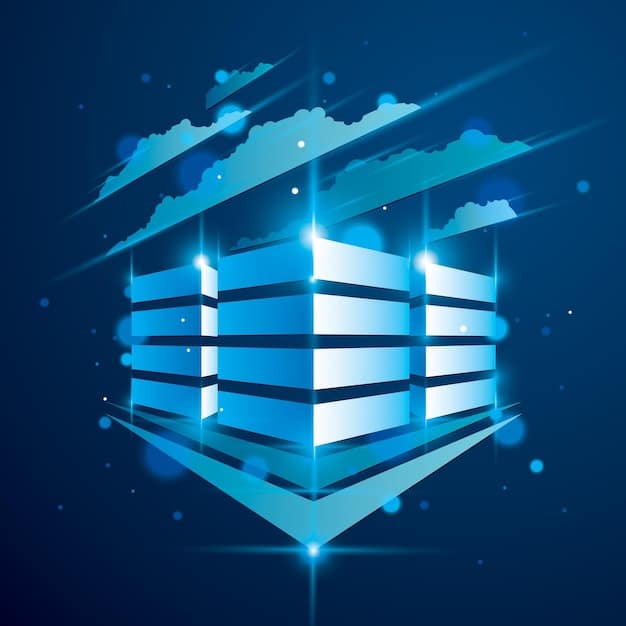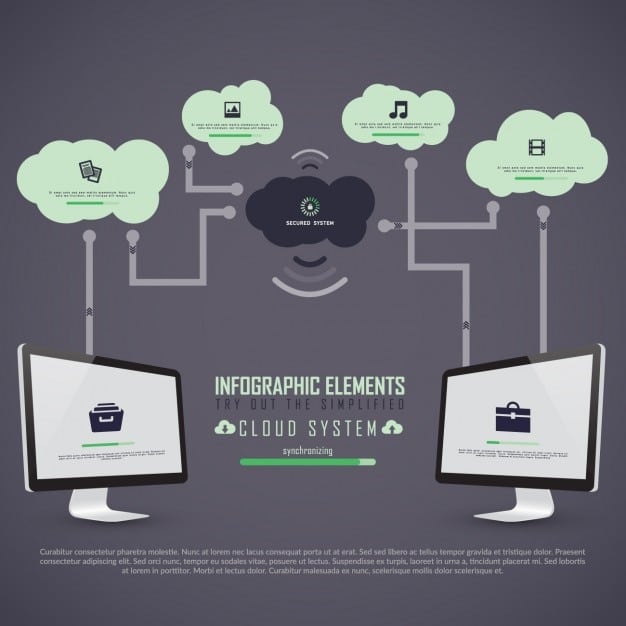Cloud Security Risks: Your Guide to Data Protection in 2025

Cloud security risks are continuously evolving, encompassing data breaches, compliance issues, and unauthorized access, making robust data protection strategies essential for organizations leveraging cloud services.
The landscape of cloud computing is constantly shifting, presenting new challenges and vulnerabilities for businesses of all sizes. Understanding and mitigating cloud security risks is paramount to maintaining the integrity, confidentiality, and availability of valuable data in 2025.
Understanding the Evolving Cloud Security Landscape
The shift to cloud-based solutions has revolutionized how businesses operate, enabling scalability, flexibility, and cost-efficiency. However, this transformation has also introduced a complex array of security challenges. Understanding these challenges is the first step in effectively addressing cloud security risks.
Shared Responsibility Model
One of the core concepts in cloud security is the shared responsibility model. This model outlines the division of security responsibilities between the cloud provider and the customer. The provider is generally responsible for the security of the cloud infrastructure itself, while the customer is responsible for the security of everything they put in the cloud, including data, applications, and identities.
It’s crucial for organizations to clearly understand their responsibilities within this model to avoid security gaps. Many breaches occur because customers mistakenly believe the provider handles all aspects of security, leading to vulnerabilities.
Common Cloud Security Threats
The cloud presents many avenues for attackers to exploit vulnerabilities. Identifying these common threats is essential for businesses concerned about cloud security risks. Misconfigurations, insufficient access controls, and data breaches are major factors for concern. These risks can lead to sensitive information being leaked or compromised.
- Data Breaches: Unauthorized access and exfiltration of sensitive data stored in the cloud.
- Misconfigurations: Incorrectly configured cloud resources, leading to vulnerabilities.
- Insufficient Access Controls: Weak or poorly implemented authentication and authorization mechanisms.
- Insider Threats: Malicious or negligent actions by individuals with authorized access.
In conclusion, navigating the evolving cloud security landscape requires a clear understanding of the shared responsibility model and common threats. Proactive security measures and continuous monitoring are vital for protecting sensitive data and maintaining a strong security posture in the cloud. This involves constant vigilance and adaptation to emerging threats.
Data Breaches and Data Loss in the Cloud
Data breaches and data loss represent some of the most significant cloud security risks. A data breach occurs when sensitive, protected, or confidential data is viewed, copied, transmitted, stolen, or used by an unauthorized individual. Data loss, on the other hand, can result from accidental deletion, hardware failure, or malicious attacks.
Causes of Data Breaches and Loss
Several factors contribute to data breaches and data loss in cloud environments. Human error, such as misconfigurations or weak passwords, often plays a significant role. Cyberattacks, including malware and ransomware, can also lead to data compromise and loss. The rise in sophisticated attacks means businesses must be continuously vigilant.
Furthermore, inadequate security measures, such as failing to encrypt sensitive data or properly manage access controls, can leave organizations vulnerable. Regular security audits help to mitigate these vulnerabilities.
Preventing Data Breaches and Loss
Preventing data breaches and data loss requires a multi-layered security approach. Implementing strong encryption for data at rest and in transit is crucial. Regular backups and disaster recovery plans can help minimize the impact of data loss events. Businesses must consider the legal and financial impacts of such breaches.

- Encryption: Protect sensitive data with strong encryption algorithms.
- Access Controls: Implement robust authentication and authorization mechanisms.
- Data Loss Prevention (DLP): Utilize DLP tools to monitor and prevent sensitive data from leaving the cloud environment.
- Regular Backups: Maintain up-to-date backups to ensure data can be recovered in case of loss.
Implementing these measures can significantly reduce the risk of data breaches and data loss, ensuring the confidentiality, integrity, and availability of your data. These measures are constantly evolving in response to a dynamic environment, requiring consistent effort.
Compliance and Regulatory Challenges in Cloud Security
Compliance and regulatory challenges are significant considerations for organizations operating in the cloud. Various regulations, such as GDPR, HIPAA, and PCI DSS, impose strict requirements on how data is handled and protected. Understanding and adhering to these regulations is essential to avoid legal and financial penalties.
Navigating Regulatory Requirements
Navigating regulatory requirements in the cloud can be complex due to the shared responsibility model. Organizations must ensure that their cloud providers meet the necessary compliance standards. This includes understanding the provider’s certifications and conducting due diligence to verify their security practices.
Additionally, businesses need to implement their own security controls to comply with specific regulatory requirements. Transparency with cloud providers is very important in such cases.
Data Residency and Sovereignty
Data residency and sovereignty are critical compliance considerations. Many regulations require data to be stored and processed within specific geographic regions. Organizations must understand these requirements and implement appropriate controls to ensure compliance. These factors may dramatically alter the costs associated with data storage.
- GDPR: Requires strict data protection standards for EU citizens’ data.
- HIPAA: Protects the privacy and security of protected health information.
- PCI DSS: Mandates security standards for handling credit card information.
- CCPA: Grants California residents specific rights regarding their personal data.
In summary, addressing compliance and regulatory challenges in cloud security requires a thorough understanding of applicable regulations, the shared responsibility model, and data residency requirements. Organizations must implement robust security controls and conduct regular audits to ensure ongoing compliance. Staying current on new legal decisions impacts businesses.
Identity and Access Management (IAM) in the Cloud
Identity and Access Management (IAM) is a critical component of cloud security risks, focusing on controlling who has access to what resources within the cloud environment. Effective IAM practices help prevent unauthorized access, data breaches, and other security incidents. Implementing strong IAM controls is essential for organizations to maintain a secure cloud posture.
Importance of Strong IAM Policies
Strong IAM policies are fundamental for securing cloud resources. These policies define who has access to specific resources and what actions they are allowed to perform. Implementing the principle of least privilege, which grants users only the minimum necessary access, is crucial for minimizing the attack surface.
Additionally, organizations should enforce multi-factor authentication (MFA) to add an extra layer of security beyond passwords. This prevents attackers from using stolen credentials to gain unauthorized access. These measures are often relatively simple to implement, giving an immediate boost to security.
Managing User Identities
Managing user identities effectively is another critical aspect of IAM. Centralized identity management systems can help streamline user provisioning, deprovisioning, and authentication. Integrating these systems with cloud providers ensures consistent access controls across the cloud environment.

- Multi-Factor Authentication (MFA): Adds an extra layer of security by requiring multiple forms of verification.
- Role-Based Access Control (RBAC): Assigns permissions based on user roles, simplifying access management.
- Centralized Identity Management: Streamlines user provisioning and authentication across the cloud environment.
- Regular Access Reviews: Periodically review user access rights to ensure they are still appropriate.
In conclusion, implementing strong IAM policies and effectively managing user identities are essential for securing cloud resources. These practices help prevent unauthorized access, reduce the risk of data breaches, and maintain a strong security posture in the cloud. IAM is a dynamic and ongoing process that needs continuous attention.
Network Security in the Cloud
Network security in the cloud involves protecting the virtual networks and infrastructure that support cloud-based applications and services. Securing cloud networks is critical for preventing unauthorized access, data breaches, and other security incidents. Understanding the unique challenges and implementing robust security measures are essential for maintaining a secure cloud environment.
Virtual Network Security
Virtual networks in the cloud need to be properly configured and secured to prevent unauthorized access. Implementing network segmentation, which divides the network into isolated segments, can help limit the impact of a security breach. Firewalls and intrusion detection systems (IDS) should be deployed to monitor and block malicious traffic.
Additionally, organizations should use virtual private networks (VPNs) to encrypt data transmitted between on-premises networks and the cloud. Security groups are useful for limiting access to critical systems. These methods are often considered foundational for any cloud implementation.
Monitoring Network Traffic
Monitoring network traffic is essential for detecting and responding to security incidents. Organizations should implement network monitoring tools to track traffic patterns, identify anomalies, and detect potential threats. Analyzing log data can provide valuable insights into security events and help improve security posture.
- Network Segmentation: Divides the network into isolated segments to limit the impact of breaches.
- Firewalls and IDS: Monitor and block malicious traffic.
- Virtual Private Networks (VPNs): Encrypt data transmitted between on-premises networks and the cloud.
- Log Analysis: Provides insights into security events and helps improve security posture.
In summary, securing network infrastructure requires comprehensive configurations and ongoing monitoring to identify unauthorized activity. Regular assessments of logs could reveal unexpected attempts to gain access. Addressing network security effectively is crucial for protecting valuable resources and safeguarding valuable data in the cloud.
Incident Response and Disaster Recovery in the Cloud
Incident response and disaster recovery are critical components of cloud security risks that focus on preparing for and responding to security incidents and disasters that could disrupt cloud-based services. A well-defined incident response plan and effective disaster recovery strategy can minimize downtime, prevent data loss, and ensure business continuity.
Developing an Incident Response Plan
An incident response plan outlines the steps an organization will take in the event of a security incident. This plan should include procedures for identifying, containing, eradicating, and recovering from incidents. Regular testing and updates are essential to ensure the plan remains effective. A swift response can often limit damages.
The plan should also define roles and responsibilities, establish communication protocols, and detail escalation procedures. Training helps familiarize employees with the plan and their roles in responding to incidents.
Disaster Recovery Strategies
Disaster recovery strategies focus on restoring business operations after a disruptive event. This includes creating backup and recovery procedures, establishing recovery time objectives (RTOs) and recovery point objectives (RPOs), and implementing redundant systems. Regular testing ensures these systems are adequate for such DR scenarios.
- Backup and Recovery: Regularly back up data and applications to ensure they can be restored in case of a disaster.
- Recovery Time Objective (RTO): The maximum acceptable downtime following a disaster.
- Recovery Point Objective (RPO): The maximum acceptable data loss following a disaster.
- Redundant Systems: Implement redundant systems to ensure continuous availability.
In conclusion, a well-defined incident response plan and effective disaster recovery strategy are essential for maintaining business continuity in the cloud. Regular testing and updates are crucial for ensuring these plans and strategies remain effective. The ability to recover quickly from adversity is crucial.
| Key Aspect | Brief Description |
|---|---|
| 🔑 Shared Responsibility | Cloud providers handle infrastructure security, while users manage their data and applications. |
| 🛡️ IAM Policies | Strong IAM policies protect cloud resources through defined access controls and user authentication mechanisms. |
| 🚨 Incident Response | Developing and testing an incident response plan can minimize the impact of security incidents. |
| 🌐 Network Security | Properly configured firewalls are crucial to preventing unauthorized network access and potential data breaches. |
Frequently Asked Questions (FAQ)
▼
The shared responsibility model dictates that cloud providers secure the infrastructure (hardware, software, networking), while customers secure what they put inside the cloud (data, applications, operating systems).
▼
Prevent data breaches by implementing strong encryption for data at rest and in transit, utilizing robust access controls, and maintaining regular data backups. Multi-factor authentication (MFA) is essential.
▼
Common challenges include adhering to GDPR, HIPAA, and PCI DSS. Data residency and sovereignty requirements also pose complications. Regularly audit your cloud configuration.
▼
IAM ensures that only authorized individuals have access to specific cloud resources. Strong IAM policies prevent unauthorized access and reduce the risk of data breaches with least privilege access.
▼
The plan should outline procedures for identifying, containing, eradicating, and recovering from incidents. Define roles, establish communication protocols, and detail escalation procedures for a coordinated response.
Conclusion
Addressing cloud security risks is critical for organizations operating in the modern digital landscape. By understanding the shared responsibility model, implementing robust security controls, and staying informed about evolving threats, businesses can protect their valuable data and maintain a strong security posture in an increasingly complex cloud environment. Continuous vigilance and adaptation are essential for long-term success.





